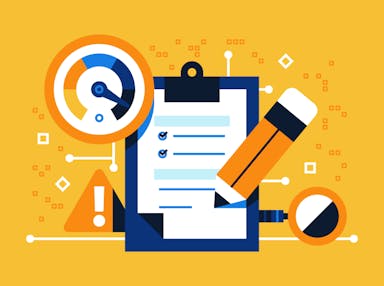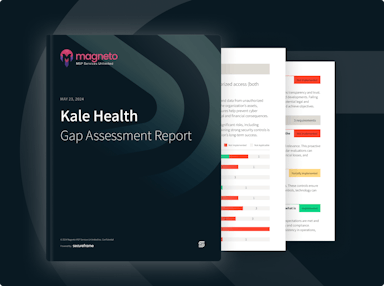
Understanding Compliance Gap Analysis: A Key Component of Compliance Programs
Anna Fitzgerald
Senior Content Marketing Manager
Rob Gutierrez
Senior Cybersecurity and Compliance Manager, CISA, CCSK, CMMC RP
As the pervasive risk of data and privacy breaches continues, global regulations and laws governing data security and privacy are increasing in number and complexity, and affecting more companies across all types of industries.
Taking a proactive approach to identifying and closing compliance gaps can help position organizations to better mitigate risk, build trust with their stakeholders, and be prepared for an audit.
In this blog post, we will explore what a compliance gap analysis is, why it matters, how it differs from a risk assessment, and the key steps involved in conducting one. We’ll also look at examples, templates, and reports associated with gap analysis. Let’s get started.
What is a compliance gap analysis?
A compliance gap analysis is the process of evaluating an organization's current policies, procedures, and practices to identify areas that fail to meet the requirements of specific regulatory standards or frameworks, such as SOC 2, ISO 27001, CMMC, and many others. This process helps organizations understand where their compliance posture currently stands, falls short, and outlines corrective actions.
Purpose of compliance gap analysis
The primary purpose of a compliance gap analysis is to assess the current state of compliance within an organization and identify gaps between what is required by the framework and what is currently in place.
It allows organizations to:
- Highlight deficiencies in policies, procedures, or controls
- Establish a roadmap for remediation
- Enhance their overall security and compliance posture
- Avoid potential legal or financial consequences of non-compliance
In short, a gap analysis provides the critical insight needed for businesses to make informed decisions about where to allocate resources and how to strengthen their compliance efforts.
The role of a compliance gap analysis in a compliance program
A compliance gap analysis serves as the foundation for an organization's compliance efforts, whether you’re getting compliant for the first time or trying to stay compliant as frameworks and regulations change over time. Particularly if just getting started with compliance, it can be a great way to kick off a compliance program and hit the ground running.
By conducting a gap analysis, organizations can identify areas where they fall short of specific regulatory or industry standards and frameworks and address them early on in their compliance journey. This enables organizations to address potential issues proactively rather than immediately before or during an audit, reducing the risk of non-compliance and enhancing overall operational resilience.
A gap analysis also aids in setting priorities and allocating resources to areas that pose the highest risks and are most likely to result in fines, penalties, or reputational damage if unaddressed.
Recommended reading

What Is Compliance Risk? How To Assess and Manage It [+ Free Templates]
Compliance gap analysis example
To better understand the purpose of a gap analysis and how it fits into a compliance program, let’s look at an example of why an organization might conduct a gap analysis for a particular example.
Take a PCI compliance gap analysis for example. Given the stringent requirements of PCI DSS, companies that process, store, transmit, or impact the security of cardholder data often conduct a gap analysis to identify weaknesses in their data security practices, particularly around the handling and protection of cardholder data.
A retail business undergoing this process would assess its current cardholder data environment (CDE) and compare it against PCI DSS requirements. The gap analysis might reveal that certain encryption protocols are outdated or that access controls are insufficient. The remediation plan might therefore involve upgrading encryption technologies and tightening user access to cardholder data.
Recommended reading

PCI DSS 4.0 Requirements: A Deep Dive into the Latest Changes and How They Affect Your Organization
Compliance gap analysis vs risk assessment
While both a compliance gap analysis and a risk assessment are crucial components of a compliance program, they have different purposes, scopes, and requirements.
- Purpose: A compliance gap analysis focuses on identifying gaps between current practices and framework requirements so organizations understand their current compliance status before undertaking a more extensive audit. A risk assessment evaluates potential threats and vulnerabilities and the likelihood of those threats and vulnerabilities causing harm to inform the next step of the risk management process (ie. risk response).
- Scope: While a compliance gap analysis is more narrowly focused on adherence to regulatory or framework compliance, a risk assessment has a broader focus. It considers operational risks, security risks, and other business threats, vulnerabilities, and issues in addition to compliance risks.
- Requirements: A gap analysis is a voluntary assessment that organizations can do to start or supplement their compliance journey and to monitor their compliance posture at any given time. Risk assessments, on the other hand, are required on a periodic basis by many frameworks. For example, risk assessments need to be done annually for PCI DSS compliance.
Recommended reading

What Is a PCI Risk Assessment? + Template
Compliance gap analysis process: The manual approach
The compliance gap analysis process typically follows these steps:

1. Define the scope
The first step in a compliance gap analysis is to clearly define the scope of the assessment. This involves identifying which regulations, standards, or frameworks the organization needs to evaluate. Depending on the industry and data they process, the organization might need to assess compliance with frameworks like PCI DSS, HIPAA, or GDPR. They may also need to comply with custom requirements, like ESG frameworks, based on customer or business needs.
Defining the scope helps to narrow the focus and ensures that only relevant policies, procedures, and controls are analyzed. Without a clearly defined scope, organizations risk wasting time and resources on areas that may not impact their specific compliance needs. Additionally, understanding the scope early on allows the organization to align its resources and efforts effectively, ensuring that the analysis is comprehensive and targeted.
2. Review current policies, procedures, and controls
Once the scope is defined, the next step is to conduct a thorough review of the organization's current policies, controls, and procedures. This includes examining documentation, practices, and the technologies currently in place to safeguard data and ensure compliance with the applicable framework requirements. The review should also evaluate how effectively these controls are being implemented and whether they are updated to reflect the latest requirements.
This step often involves cross-functional teams, including IT, legal, HR, and compliance departments, to ensure that the review is holistic. The manual approach requires collecting evidence and testing controls manually to understand how well the current controls meet compliance requirements, which can be time-consuming and resource-intensive.
3. Identify gaps
The next step is to compare the organization's current practices and controls against the specific requirements of the regulatory framework. This comparison helps to identify any gaps where policies, procedures, and controls fall short of meeting compliance standards.
Gaps could be:
- missing or inadequate controls
- outdated policies
- incomplete documentation
Identifying these gaps requires a detailed understanding of both the framework requirements and the organization's internal processes. The manual approach often involves going through lengthy spreadsheets and comparing each requirement to the organization's practices, making it a time-intensive and tedious process.
During this step, it’s important to document each gap identified and describe the potential risks associated with it.
4. Prioritize high-risk gaps
Not all gaps carry the same level of risk or urgency, which is why it's essential to prioritize them. During this step, gaps are ranked based on their potential impact on the organization, taking into consideration the severity of non-compliance, the likelihood of a breach or issue occurring, and the consequences of non-compliance, such as fines, data breaches, or reputational damage.
Prioritization can be done by assessing the level of risk associated with each gap—high-risk gaps should be addressed immediately, while lower-risk issues can be addressed later. The manual approach often involves qualitative risk assessments, where expert judgment is needed to evaluate which gaps require immediate attention.
An example of a high-priority compliance gap is the failure to encrypt sensitive data, such as customer payment information or healthcare records, both at rest and in transit. Many frameworks, including PCI DSS, HIPAA, and GDPR, require encryption as a control to protect sensitive data. The lack of encryption poses significant risks, including fines and penalties, data breaches, and loss of customer trust.
5. Create a remediation plan
Once gaps are identified and prioritized, create a remediation plan outlining specific actions the organization will take to close the gaps, including deadlines, resource allocation, and responsibilities. The plan should be realistic, taking into account the complexity of each task and the availability of resources.
A strong remediation plan is key to moving the organization toward compliance. Without a clear plan, the organization risks falling behind on addressing critical gaps, leaving them exposed to potential risks. The manual approach to remediation planning often requires careful coordination and collaboration among various departments, as implementing controls and the steps needed to address any deficient controls are typically cross-functional.
6. Monitor progress
Compliance is not a one-time effort; it requires continuous monitoring to ensure that the identified gaps are being remediated effectively. This step involves regularly tracking the progress of remediation efforts, ensuring that deadlines are being met, and actions are being taken to bring the organization closer to compliance. Monitoring also helps identify any new gaps that may arise as framework requirements evolve.
When done manually, this step often involves status meetings, audits, and regular updates from each team responsible for different areas of remediation. While crucial for ensuring that compliance efforts stay on track, this method can be challenging to maintain over the long term without dedicated resources, expertise, and technology.
Let’s take a closer look at how automation can simplify this process.
How automation can help simplify and speed up the gap analysis process
Understanding what gaps exist in an organization’s security and compliance posture and how to fill them is an ongoing challenge that requires expertise and resources — and many risk and compliance professionals report a lack of both. In the 2023 Thomson Reuters Risk & Compliance Survey Report, the top factors cited as obstacles to a team’s confidence in their ability to address compliance risks were a lack of knowledgeable personnel and inadequate resources.
Organizations lacking the knowledgeable personnel and resources required to manage spreadsheets, manually scan regulatory websites to track changes and assess the impact on their organization, and complete other time-consuming activities involved in a manual approach to compliance gap analysis may turn to automation and technology.
Automation can significantly simplify and accelerate this process by reducing the time spent on repetitive and labor-intensive tasks. Here’s how automation can transform the compliance gap analysis process:
- Pre-authored frameworks and control mapping: Automation tools have pre-authored frameworks whose requirements are automatically mapped to controls and tests. This eliminates the need to manually compile and map out framework requirements in spreadsheets, saving significant time and effort. Pre-built frameworks also ensure consistency and accuracy, and typically leverage common controls when possible to enable an organization to meet multiple framework requirements with a common control and reduce duplicate work.
- Automated data collection: Instead of manually gathering data from various systems to assess what controls your organization has in place, automated tools can pull relevant data from multiple sources via integrations. This ensures that the most up-to-date information is available for analysis and eliminates the need for manual data entry.
- Streamlined gap identification: Automated systems can quickly compare your current controls against the latest framework requirements via automated tests. This drastically reduces the time required for identifying compliance gaps, which would typically be a manual and error-prone process.
- Remediation guidance: A compliance automation platform not only identifies gaps in your organization’s compliance posture — it also offers step-by-step remediation guidance so you can quickly fix those gaps and speed up time-to-compliance.
- Efficient remediation tracking: Automation platforms can also help manage remediation efforts by tracking progress and assigning tasks to relevant stakeholders. This provides real-time visibility into how well your organization is closing gaps, while offering accountability and better coordination across departments.
- Real-time continuous monitoring: Automated compliance tools can continuously monitor your systems and processes to ensure compliance. These tools can send real-time alerts when gaps or discrepancies are detected, allowing organizations to address issues promptly before they escalate into larger problems.
- Regulatory updates: Instead of needing to manually scan regulatory websites to stay updated, an automated compliance tool should reflect the latest changes in regulations and standards, such as PCI DSS 4.0.1, and show any impact on your organization. This ensures that your compliance program stays current with evolving requirements without the need for constant manual monitoring.
By leveraging automation, organizations can reduce the workload on their teams, improve the accuracy of gap assessments, and ensure that they remain compliant with ever-evolving regulatory frameworks.
Recommended reading

5 Hardest Things About Security Compliance and How Technology Can Help
How Service Partners can leverage automated gap assessments
IT security service providers, like vCISOs or MSPs, also face challenges when conducting gap analyses for their clients that can be solved with automation. While they have the knowledge and expertise to conduct these assessments, they must overcome issues with efficiency and scalability.
A manual approach can take weeks, requiring them to compile controls in spreadsheets, map them to applicable framework requirements, interview organizational leadership and other stakeholders, and more. When trying to do them for multiple clients at a time, this is a huge strain on their business. Plus, results of a manual gap analysis can fall quickly out of date due to changes in regulatory frameworks and industry standards and the client’s environment.
The Secureframe Gap Assessment can help Secureframe Service Providers address these challenges. This free tool is designed to facilitate swift and straightforward gap assessments for clients and prospects across any available framework that Secureframe supports.
Secureframe Gap Assessment represents a pared-down version of Secureframe's technology, tailored to enable Secureframe partners to install essential integrations and complete a questionnaire directly within the product.

The tool automatically conducts the gap analysis and generates a report that showcases the results, both at a high-level summary and in detailed form.

This report highlights the gaps in the client's security posture or compliance status, providing clear insights into areas needing improvement.

Secureframe Service Providers can use this tool to quickly and easily uncover areas of non-compliance and potential risk while demonstrating value to clients.
To schedule a demo or learn more about the Secureframe Service Partner Program, visit our website or contact partners@secureframe.com.
Recommended reading

Secureframe Gap Assessment: A Free Tool to Empower Our Service Partners
Why use Secureframe to automate the compliance gap analysis process
A compliance gap analysis is an essential tool for ensuring that your organization or your client's organization is meeting regulatory and industry standards, providing insight into where improvements are needed and helping to prioritize actions to mitigate risk.
Secureframe automates the process, making it faster and easier to achieve and maintain compliance. With Secureframe, you get:
- Guidance from compliance experts: As a Secureframe customer, you can reach out to a compliance manager to have an in-depth discussion about your current environment and scope to help determine exactly which frameworks and requirements are applicable to you and how you can implement controls within your environment in order to meet the latest version of the framework(s) you’re pursuing.
- Automated evidence collection: Secureframe automates evidence collection across various frameworks, providing a constantly evolving and up-to-date gap analysis for each framework your organization is pursuing. Once you set up integrations with tools and applications that are being used across your organization, the Secureme platform will show you exactly what gaps exist in your compliance posture based on your unique configurations and IT infrastructure.
- Intuitive dashboards: As you work through a framework, closing gaps and completing activities within the Secureframe platform, the dashboard will update showing your progress percentage toward compliance.
- Control mapping across frameworks: Secureframe automatically maps control and tests across frameworks. That not only means you’ll see exactly what tasks you need to complete to become compliant — it also reduces redundant work and speeds up time-to-compliance as you strive to comply with more frameworks over time.
- AI-powered remediation: With ComplyAI for Remediation, Secureframe provides automated, step-by-step remediation guidance to address compliance issues quickly and efficiently.
- Simplified task management: Secureframe simplifies the assignment, tracking, and management of compliance-related tasks, ensuring timely remediation of any compliance gaps and accountability across teams.
- Streamlined regulatory change management: The Secureframe team not only reaches out to notify customers of any regulatory changes affecting their compliance posture. The Secureframe platform is also built and maintained by compliance experts, so any regulatory changes or framework updates are reflected in the platform. This ensures you always have an up-to-date gap analysis of your organization’s current practices compared to the latest version of a framework.
- Continuous monitoring: Secureframe enables real-time monitoring of controls and automatically detects misconfigurations, ensuring compliance at all times.
To see how 95% of Secureframe users save time and resources obtaining and maintaining compliance, schedule a demo.
FAQs
What is a compliance gap analysis?
A compliance gap analysis is a process that identifies areas where an organization's current policies, procedures, and practices fail to meet the requirements of specific frameworks, such as SOC 2, ISO 27001, CMMC, or custom ones. It helps organizations understand where they fall short in meeting compliance requirements so they can take corrective action.
Why is a compliance gap analysis important?
Conducting a compliance gap analysis is crucial because it highlights areas of non-compliance that could expose your organization to compliance risks such as legal penalties, data breaches, and loss of business. It also helps streamline remediation efforts and provides a clear roadmap to achieve compliance.
What are the common steps in a compliance gap analysis?
Typically, a compliance gap analysis involves:
- Reviewing applicable standards and requirements
- Assessing current practices and controls
- Identifying areas of non-compliance
- Recommending remediation actions
- Prioritizing steps to close the gaps based on risk levels
How often should a compliance gap analysis be conducted?
A compliance gap analysis should be conducted regularly, especially before audits, when regulations or internal processes change, or when adopting new technology or business practices. Performing analyses on a regular basis helps organizations stay ahead of potential issues and maintain continuous compliance.
What are the benefits of conducting a compliance gap analysis?
The primary benefits include:
- Early detection of compliance risks
- Streamlined audits
- Cost savings by preventing regulatory fines, penalties, and other consequences of non-compliance
- Improved overall security posture
- Enhanced trust with customers, partners, and auditors by demonstrating proactive compliance efforts

Anna Fitzgerald
Senior Content Marketing Manager
Anna Fitzgerald is a digital and product marketing professional with nearly a decade of experience delivering high-quality content across highly regulated and technical industries, including healthcare, web development, and cybersecurity compliance. At Secureframe, she specializes in translating complex regulatory frameworks—such as CMMC, FedRAMP, NIST, and SOC 2—into practical resources that help organizations of all sizes and maturity levels meet evolving compliance requirements and improve their overall risk management strategy.

Rob Gutierrez
Senior Cybersecurity and Compliance Manager, CISA, CCSK, CMMC RP
Rob Gutierrez is an information security leader with nearly a decade of experience in GRC, IT audit, cybersecurity, FedRAMP, cloud, and supply chain assessments. As a former auditor and security consultant, Rob performed and managed CMMC, FedRAMP, FISMA, and other security and regulatory audits. At Secureframe, he’s helped hundreds of customers achieve compliance with federal and commercial frameworks, including NIST 800-171, NIST 800-53, FedRAMP, CMMC, SOC 2, and ISO 27001.